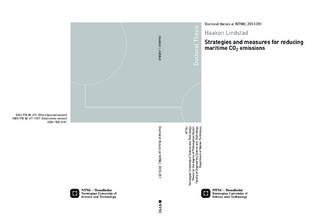| dc.contributor.author | Lindstad, Haakon | nb_NO |
| dc.date.accessioned | 2014-12-19T12:08:54Z | |
| dc.date.available | 2014-12-19T12:08:54Z | |
| dc.date.created | 2013-09-04 | nb_NO |
| dc.date.issued | 2013 | nb_NO |
| dc.identifier | 645351 | nb_NO |
| dc.identifier.isbn | 978-82-471-4516-6 (printed version) | nb_NO |
| dc.identifier.isbn | 978-82-471-4517-3 (electronic version) | nb_NO |
| dc.identifier.uri | http://hdl.handle.net/11250/238419 | |
| dc.description.abstract | CO2 emissions from maritime transport represent 3.3% of global anthropogenic CO2 emissions. These emissions are forecasted to increase by 150% - 250% up to 2050, due to increased freight volumes (Buhaug et al., 2009). Fulfilling anticipated climate requirements (IPCC, 2007) could require the sector to reduce emissions per freight unit transported by a factor of five or six.
This thesis, focus on strategies and measures for reducing maritime CO2 emissions within the maritime sector. These emissions can also be reduced outside the sector through market based measures (MBM) by buying emission quotas, which basically means that the shipping sector pays other sectors for reducing their emissions. New and emerging technologies can also contribute to emission reductions. However the objective of this work has been to focus on reducing emission through improving energy efficiency.
One of the objectives for this research, has been to investigate if the available strategies and measures for improving energy efficiency on its own could enable emission reductions by up to 85% per freight unit transported by 2050, which is a substantial challenge. The question is thus how to realize the required greenhouse gas reductions, and at the same time meet sea-transport system mission objectives. A fundamental criterion for enabling this has been to establish the main drivers for making ships more energy efficient and environmentally friendly, and the relationship between the main drivers. The methodological strategy to achieve this has been to include both the micro and macro perspective of shipping.
This thesis consists of three parts. The first part contains: an introduction to maritime transport and emission reductions; the state of the art study; the context for my research and the introduction to my journal papers. The second part contains: the six papers which are the major contribution to this thesis. The third part contains how this research has contributed to state of the art, conclusions and further research. | nb_NO |
| dc.language | eng | nb_NO |
| dc.publisher | Norges teknisk-naturvitenskapelige universitet, Fakultet for ingeniørvitenskap og teknologi, Institutt for marin teknikk | nb_NO |
| dc.relation.ispartofseries | Doktoravhandlinger ved NTNU, 1503-8181; 2013:201 | nb_NO |
| dc.relation.haspart | Lindstad, Haakon; Asbjørnslett, Bjørn Egil; Pedersen, Jan Tore. Green Maritime Logistics and Sustainability. Maritime logistics - Contemporary issues: 227-243, 2012. | nb_NO |
| dc.relation.haspart | Lindstad, Haakon; Asbjornslett, Bjorn E.; Stromman, Anders H.. Reductions in greenhouse gas emissions and cost by shipping at lower speeds. Energy Policy. (ISSN 0301-4215). 39(6): 3456-3464, 2011. <a href='http://dx.doi.org/10.1016/j.enpol.2011.03.044'>10.1016/j.enpol.2011.03.044</a>. | nb_NO |
| dc.relation.haspart | Lindstad, Haakon; Asbjornslett, Bjorn E.; Jullumstro, Egil. Assessment of profit, cost and emissions by varying speed as a function of sea conditions and freight market. Transportation Research Part D - Transport and Environment. (ISSN 1361-9209). 19: 5-12, 2013. <a href='http://dx.doi.org/10.1016/j.trd.2012.11.001'>10.1016/j.trd.2012.11.001</a>. | nb_NO |
| dc.relation.haspart | Lindstad, Haakon; Asbjornslett, Bjorn E.; Stromman, Anders H.. The importance of economies of scale for reductions in greenhouse gas emissions from shipping. Energy Policy. (ISSN 0301-4215). 46: 386-398, 2012. <a href='http://dx.doi.org/10.1016/j.enpol.2012.03.077'>10.1016/j.enpol.2012.03.077</a>. | nb_NO |
| dc.relation.haspart | Lindstad, Haakon; Strømman, Anders H.. Comparing the cost and emissions of maritime and air transport. . | nb_NO |
| dc.relation.haspart | Lindstad, H.; Jullumstrø, E.; Sandaas, Inge. Reduction in cost and emissions with new bulk ships designed enabled by the Panama Canal expansion. Energy Policy. (ISSN 0301-4215). 59: 341-349, 2013. <a href='http://dx.doi.org/10.1016/j.enpol.2013.03.046'>10.1016/j.enpol.2013.03.046</a>. | nb_NO |
| dc.title | Strategies and measures for reducing maritime CO₂ emissions | nb_NO |
| dc.type | Doctoral thesis | nb_NO |
| dc.contributor.department | Norges teknisk-naturvitenskapelige universitet, Fakultet for ingeniørvitenskap og teknologi, Institutt for marin teknikk | nb_NO |
| dc.description.degree | PhD i marin teknikk | nb_NO |
| dc.description.degree | PhD in Marine Technology | en_GB |

